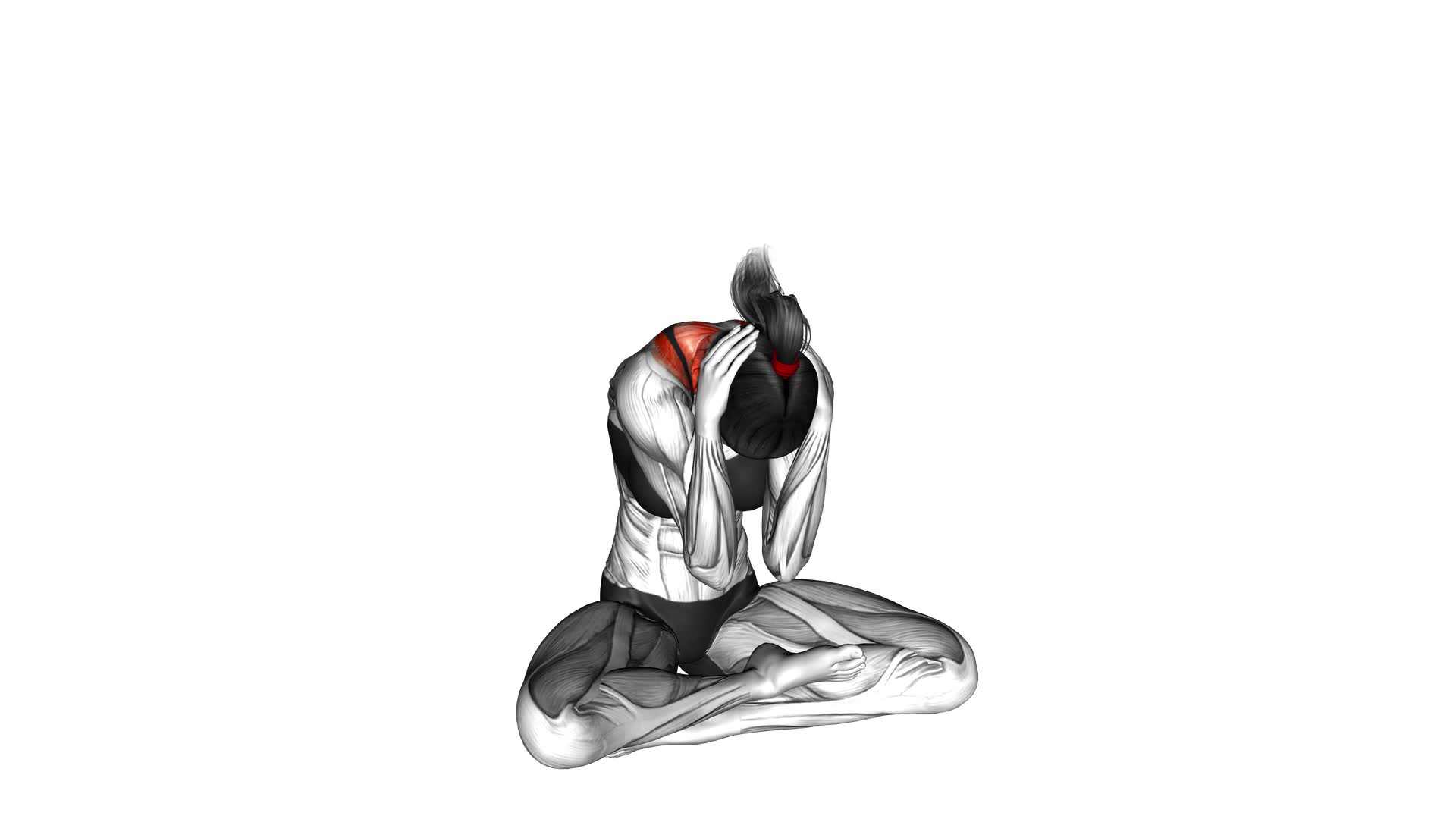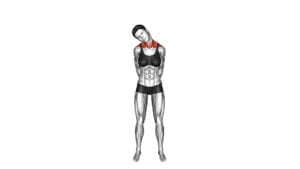Sitting Neck Stretch (female) – Video Exercise Guide & Tips

Are you experiencing tightness in your neck? Try the sitting neck stretch!
Watch This Exercise Video
In this video exercise guide, we'll show you step-by-step instructions for this effective stretch. Discover the benefits, proper alignment, and common mistakes to avoid.
Plus, we'll share tips for increasing intensity and effectiveness. Whether you're a beginner or advanced, modifications are available for all fitness levels.
Say goodbye to neck tension and hello to relief with this simple stretch. Let's get started!
Key Takeaways
- Alleviates neck pain and stiffness caused by prolonged sitting or poor posture
- Releases tension and promotes better blood circulation
- Improves flexibility and range of motion in the neck and shoulders
- Reduces the risk of muscle imbalances and discomfort
Benefits of the Sitting Neck Stretch
You can experience relief from neck tension and improve flexibility by regularly performing the sitting neck stretch. This stretching technique offers various health benefits that are worth incorporating into your daily routine.
Firstly, the sitting neck stretch helps to alleviate neck pain and stiffness caused by prolonged sitting or poor posture. By stretching the muscles in your neck, you can release tension and promote better blood circulation, reducing the risk of muscle imbalances and discomfort.
Additionally, this stretch can improve your overall flexibility and range of motion in the neck and shoulders. It targets the muscles in the neck, upper back, and shoulders, promoting better posture and reducing the risk of injuries.
Regular practice of the sitting neck stretch can also help in relieving headaches and migraines caused by muscle tension in the neck and shoulders. Remember to always perform the stretch gently and without any pain.
Incorporating this stretching technique into your daily routine can lead to significant improvements in your neck health and overall well-being.
Proper Alignment and Positioning
To achieve proper alignment and positioning during the sitting neck stretch, focus on maintaining a straight spine and relaxed shoulders. Proper alignment is essential for injury prevention and maximizing the benefits of this stretch. Start by sitting up tall, with your feet flat on the floor and your back against the chair. Keep your chin parallel to the ground and avoid slouching or hunching forward. This will help ensure that your spine is in a neutral position, allowing for proper muscle relaxation and preventing strain on the neck and shoulders.
Next, focus on relaxing your shoulders. As you perform the stretch, let your shoulders drop down and away from your ears. Avoid tensing or shrugging them up towards your neck. This will help release any tension or tightness in the muscles surrounding your neck, promoting better muscle relaxation and flexibility.
Remember to breathe deeply and relax your entire body throughout the stretch. Inhale deeply through your nose, filling your lungs with air, and exhale slowly through your mouth. This will help promote relaxation and aid in releasing any tension or stress in your neck and shoulders.
Step-by-Step Instructions for the Exercise
Maintain proper alignment and positioning during the sitting neck stretch by following these step-by-step instructions.
To begin, sit up straight in a chair with your feet flat on the ground. Relax your shoulders and place your hands on your thighs. Take a deep breath in to prepare for the stretch.
- Tilt your head to the right: Slowly tilt your head towards your right shoulder, feeling a gentle stretch on the left side of your neck. Hold this position for 10-15 seconds.
- Return to center: Bring your head back to the center and take a breath.
- Tilt your head to the left: Now, tilt your head towards your left shoulder, feeling a stretch on the right side of your neck. Hold for 10-15 seconds.
- Return to center: Bring your head back to the center and take a breath.
- Chin to chest: Lower your chin towards your chest, feeling a stretch in the back of your neck. Hold for 10-15 seconds.
- Return to center: Bring your head back to the center and take a breath.
By performing these step-by-step instructions, you can experience the benefits of stretching your neck, such as relieving tension, improving flexibility, and reducing neck and shoulder pain.
Common Mistakes to Avoid
One common mistake to avoid when performing the sitting neck stretch is failing to maintain proper alignment and positioning. This can lead to unnecessary strain on the neck and increase the risk of injury. To ensure you're avoiding injury and maintaining proper form during the sitting neck stretch, keep the following points in mind:
- Keep your spine straight: Sit up tall and avoid slouching or rounding your shoulders. This will help to maintain proper alignment and prevent strain on the neck.
- Relax your shoulders: Avoid tensing up your shoulders while performing the stretch. Instead, allow them to relax and sink down away from your ears. This will help to release tension in the neck and promote a deeper stretch.
- Engage your core: By engaging your core muscles, you provide stability and support to your spine, which in turn helps to maintain proper form during the stretch. This will also prevent excessive strain on the neck.
Tips for Increasing Intensity and Effectiveness
To maximize the intensity and effectiveness of the sitting neck stretch, try incorporating small, controlled movements into the exercise. By adding these movements, you can increase resistance and challenge your neck muscles even more. One way to do this is by gently pushing against your hand with your head as you perform the stretch. Apply just enough pressure to feel the muscles working, but be careful not to strain or cause any pain.
Another tip for increasing intensity is to explore advanced variations of the sitting neck stretch. One option is to use resistance bands or weights to add extra resistance to the exercise. You can wrap a resistance band around the back of your head and hold each end with your hands, then perform the stretch as usual. The resistance provided by the band will make the exercise more challenging.
Additionally, you can try performing the sitting neck stretch on an exercise ball or a stability ball. Sitting on the ball will engage your core muscles and require additional stability, which can intensify the stretch.
Precautions and Modifications for Different Fitness Levels
To ensure safety and accommodate different fitness levels, it's important to make necessary precautions and modifications when performing the sitting neck stretch. Here are some tips to help you perform this exercise safely and effectively:
- Start with gentle movements: If you're a beginner or have any neck or spine issues, it's important to start with gentle movements. Avoid any sudden or forceful stretches that may cause strain or injury. Instead, focus on slow and controlled movements to gradually increase flexibility.
- Maintain proper posture: It's crucial to maintain proper posture throughout the exercise. Sit up straight with your shoulders relaxed and your chin slightly tucked in. This will help to align your neck and prevent unnecessary strain.
- Listen to your body: Pay attention to any discomfort or pain during the exercise. If you experience any discomfort, stop immediately and consult a healthcare professional. Remember that everyone's body is different, so it's important to modify the stretch to suit your individual needs.
Frequently Asked Questions
How Long Should I Hold the Sitting Neck Stretch Position?
When doing the sitting neck stretch, it's important to know how long to hold the position for maximum benefit. Holding the stretch for about 20-30 seconds is a good starting point. This will help improve flexibility and reduce tension in your neck muscles.
Remember to maintain proper form by sitting up straight, keeping your shoulders relaxed, and gently tilting your head to the side.
Always listen to your body and adjust as needed.
Can I Perform the Sitting Neck Stretch if I Have a History of Neck Injuries?
If you've had neck injuries in the past, it's important to take precautions when performing the sitting neck stretch. The sitting neck stretch may not be suitable for everyone with a history of neck injuries.
It's recommended to consult with a healthcare professional or a certified trainer who can provide alternative exercises for neck flexibility that are safer for you. Your safety and well-being should always be a priority when engaging in any exercise routine.
Is It Normal to Feel a Slight Discomfort During the Exercise?
Feeling a slight discomfort during the exercise is normal. It's a sign that your neck muscles are being stretched and worked. This discomfort shouldn't be severe or painful.
The sitting neck stretch is designed to improve your neck flexibility, which comes with many benefits like reducing muscle tension and improving posture. Remember to listen to your body and stop if you experience any sharp or intense pain.
Can the Sitting Neck Stretch Help Reduce Tension Headaches?
The sitting neck stretch is a great exercise to help reduce tension headaches. By improving neck flexibility, it can relieve the tension in your neck muscles that often leads to these headaches.
There are different variations of the sitting neck stretch that you can try to target different areas of your neck and shoulders. Incorporating this exercise into your routine can provide you with the benefits of reduced tension headaches and improved neck flexibility.
Are There Any Alternative Exercises to the Sitting Neck Stretch for Neck Flexibility?
There are indeed alternative exercises you can try to improve neck flexibility. Increasing neck flexibility has several benefits, including reducing muscle tension and improving posture.
Some alternatives to the sitting neck stretch include neck rolls, neck tilts, and shoulder shrugs. These exercises can help stretch and strengthen the muscles in your neck, promoting greater flexibility and range of motion.
Incorporating these exercises into your routine can provide similar benefits to the sitting neck stretch.
Conclusion
Incorporating the sitting neck stretch into your exercise routine can provide numerous benefits, such as improving flexibility and relieving tension in the neck and shoulders.
By following proper alignment and positioning, and avoiding common mistakes, you can maximize the effectiveness of this stretch.
Additionally, by gradually increasing intensity and considering modifications for different fitness levels, you can further enhance its impact.
Remember to consult with a healthcare professional before starting any new exercise program.

Author
Years ago, the spark of my life’s passion ignited in my mind the moment I stepped into the local gym for the first time. The inaugural bead of perspiration, the initial endeavor, the very first surge of endorphins, and a sense of pride that washed over me post-workout marked the beginning of my deep-seated interest in strength sports, fitness, and sports nutrition. This very curiosity blossomed rapidly into a profound fascination, propelling me to earn a Master’s degree in Physical Education from the Academy of Physical Education in Krakow, followed by a Sports Manager diploma from the Jagiellonian University. My journey of growth led me to gain more specialized qualifications, such as being a certified personal trainer with a focus on sports dietetics, a lifeguard, and an instructor for wellness and corrective gymnastics. Theoretical knowledge paired seamlessly with practical experience, reinforcing my belief that the transformation of individuals under my guidance was also a reflection of my personal growth. This belief holds true even today. Each day, I strive to push the boundaries and explore new realms. These realms gently elevate me to greater heights. The unique combination of passion for my field and the continuous quest for growth fuels my drive to break new ground.



